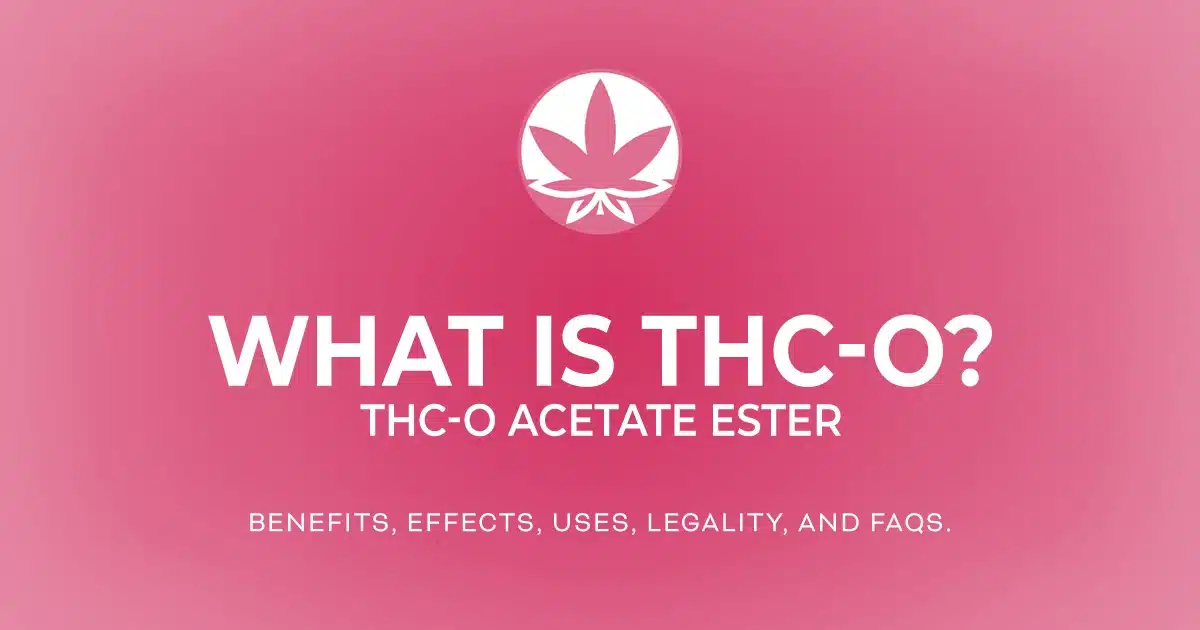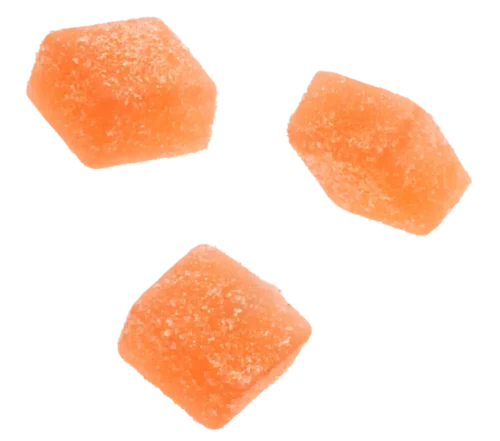What Is THC-O?


Christopher Visser
Multi-Cannabis Business Owner
Christopher Visser, the Founder and CEO of Cannabidiol Life and THCGummies.com, is a distinguished figure in the CBD industry, recognized for his pioneering contributions since 2016. With over 120 published articles, Christopher has become a reputable cannabis researcher, writer, and author. He's built two prosperous cannabis ventures that collectively generated millions in annual sales. His in-depth analysis of numerous cannabis studies, collaboration with medical professionals, and personal engagement with thousands of customers underline his expertise and commitment to advancing cannabis understanding daily.
-
 Written By:
Christopher Visser
Written By:
Christopher Visser
- Published:
- Updated: February 8, 2024
- Too Quiet, Light Up The Convo!
This thorough guide on, THC-O Acetate Ester takes a deep look at this intriguing compound, uncovering its potency, psychedelic effects, legality, and overall significance in the Cannabis cannabinoid family.
This THC-O overview promises to deepen your understanding, whether you're just beginning or well-versed in the realm of cannabinoids.
Table of Contents
- Tags: Semi-Synthetic, What Is
THC-O, also referred to as THC-O acetate, ATHC, THC-Oa, or its scientific term O-acetyl-Δ9-THC, represents an acetate ester derivative of THC. This compound, traditionally recognized among experts by these names, has been widely abbreviated to THC-O for simplicity in conversation. And if THC-O wasn’t short enough, you’ll see some referring to it as THCO or THC O.
Short Summary
- THC-O is a semi-synthetic cannabinoid 2x more potent than Delta-9 THC with psychedelic effects
- The use of THC-O carries risks such as safety concerns, side effects, overdose possibilities & legal ambiguity. Consult your physician & be aware of local regulations.
- Responsible consumption in moderation is advised to avoid long-term consequences, including Cannabinoid Hyperemesis Syndrome & cognitive impairments.
WHAT IS THC-O ACETATE? A SEMI-SYNTHETIC CANNABINOID
THC-O acetate is a powerful semi-synthetic cannabinoid derived from cannabis that has psychoactive, psychotropic, and psychedelic effects when consumed.
THC-O acetate has been gaining attention lately because of its hyper expansion in hemp products while the legalities are being heavily debated by local and federal governments.
THC-O Acetate Or THC-O Acetate Ester, Which Is Correct?
“THC-O Acetate” is generally recognized as the correct term in the scientific community. This term refers to the acetate ester of THC (Tetrahydrocannabinol). The term “ester” in “THC-O Acetate Ester” is redundant because an “acetate” is an ester of acetic acid. However, the naming conventions can vary depending on the specific contexts and conventions used within different fields or communities.
So, more times than not, THC-O Acetate is the correct name.
Origins And Development
The origins of THC-O can be traced back to the 1940s, with U.S. military scientists initiating research on this compound in 1949. The U.S. Drug Enforcement Administration (DEA) first encountered THC-O-acetate as a potential controlled substance analog of THC in 1978.
The purpose of THC-O was initially hypothesized to have enhanced psychedelic effects with more potent effects compared to Delta-9 THC. In turn, this makes THC O acetate ester much more potent that Delta 8 THC as well.
Chemical Structure And Potency
When it comes to potency, THC-O stands out among cannabinoids. It is more intoxicating than the cannabinoids Delta-8, Delta-10, or HHC and even more potent than Delta-9 THC. This increased potency is attributed to its higher bioavailability, which allows THC-O to be more readily absorbed and utilized by the body.
THC-O acetate is more potent than Delta-9 THC. In fact, it has been found to be three times stronger.
PRODUCTION PROCESS: HOW THC-O ACETATE IS MADE
Making THC-O begins by extracting Delta-8 THC, Delta-9 THC, or CBD, from hemp or marijuana plants. It’s simpler to make THC-O from Delta-8 or Delta-9 THC in comparison to CBD because CBD must be converted to D8 or D9-THC first.
Once either Delta-8 or Delta-9 THC is available, it is mixed with a substance called acetic anhydride to create THC-O. A risky method, but effective in organic chemistry.
What Is Acetic Anhydride?
Acetic anhydride is a colorless liquid and an important reagent in organic chemistry.
How Is Acetic Anhydride Used?
It is primarily used to make a component of photographic films and textiles, but its other major use is for the production of aspirin and other pharmaceuticals.
In regards to organic reactions, acetic anhydride is used to introduce an acetyl group into a molecule during a chemical reaction. However, it’s worth noting that it’s a corrosive and dangerous chemical if not handled properly, capable of causing harm to the eyes, skin, and respiratory system. But be aware, this method can be risky. The chemicals used can be dangerous and highly reactive.
Potential Benefits And Applications
Despite the concerns surrounding THC-O Acetate, there are potential benefits and applications to consider when ingested. Some of these benefits include the euphoric and psychedelic effects it produces, its higher bioavailability compared to other forms of THC, and even possible medical uses, such as pain relief, stress reduction, anti-nausea, anti-anxiety, appetite stimulation, improved sleep, and cancer-related symptoms.
Did I just say that?
Yes, but please note, this is not factual, it’s purely anecdotal — a common hypothesis, at best.
Let me explain…
Although research on the potential therapeutic benefits of THC-O (tetrahydrocannabinol-o-acetate) for specific medical conditions remains extremely limited to none. THC-O is a semi-synthetic compound created with a natural cannabinoid. And if pharmaceutical companies can make aspirin effective (a pure synthetic compound) with Acetic anhydride, why is THC-O so different?
THC-O is by product of THC. Thus, its potential therapeutic benefits by being more potent than THC and mimicking the effects from THC, cannot be totally thrown away.
There are thousands of medical studies that show the potential medical use of THC for a range of medical conditions. If I was lying, why would the World Health Organization (WHO) suggest a change in international legislation regarding cannabis, in response to increasing data supporting its medicinal use?
Resource: Learn more about the potential benefits of THC.
It’s crucial to understand that existing research on THC, does NOT infer that the results of THC research would be the same results for THC-O, but it does leave the door open for comparing their potential.
Euphoric and Psychedelic Effects
The euphoric and psychedelic effects of THC-O are a major draw for many cannabis users. These effects can include relaxation, emotional release, and sedation.
However, it is important to note that THC-O is a potent psychedelic cannabinoid and can induce adverse effects such as anxiety, paranoia, and dizziness. The psychotropic effects of THC-O are more pronounced than those of regular THC, making it essential for users to exercise caution and moderation when consuming this powerful substance.
Bioavailability
One of the reasons for the increased potency of THC-O is its higher bioavailability compared to other forms of THC. Bioavailability refers to the extent and rate of absorption of a substance into the bloodstream, allowing it to reach its site of action.
For example, when ingested orally, the bioavailability of THC is estimated to be between 4% and 20%, while the bioavailability of THC-O is significantly higher.
Research, Academic Studies, & Law Changes on THC-O Acetate Ester
- Between 1949 and 1975, THC acetate ester was researched as a potential non-lethal incapacitating substance as part of the Edgewood Arsenal experiments. When given to dogs, it was found to induce ataxia (uncontrolled muscle movements) about twice as effectively as THC.
- The U.S. DEA first came across THC-O-acetate in 1978, where it appeared to be a modified version of THC, a controlled substance.
- THC-O-acetate was declared a Class A drug in the UK in a 1995 case, and was also identified by the police in New Zealand in the same year.
- Following changes in U.S. laws around 2018, THC-O-acetate started to be increasingly used as a recreational drug. Yet, there are concerns due to the absence of safety data or quality control testing, considering its limited usage history and potentially harmful chemicals used in its production.
- A study examined four products with cannabinoids, including THC-O in June of 2022 and discovered the presence of THC-O Acetate in products available for sale. The report emphasized the lack of sufficient clinical or pharmacological data about these new synthetic cannabinoids or novel psychoactive substances.
- In 2022, a study by Portland State University suggested that THC-O-acetate and vitamin e acetates, might decompose to form a potentially lethal ketene gas when heated to 340 °C (644 °F). Ketene gas can be fatal at concentrations of 5 parts per million.
- As of March 23, 2023, THC-O-acetate, along with several other synthetic cannabinoids, was included in the DEA’s list of controlled substances.
Federally Legality & Local State Regulations For THC-O
Before I get into every nit-picking detail, here is the summary:
The United States Ninth Circuit Court of Appeals said that as long as a product made from hemp has less than 0.3% of a specific type of THC (Δ9-THC), it can be legally sold and even trademarked. This is because the Agricultural Improvement Act of 2018 says that these kinds of products can be considered legal “hemp.” The Controlled Substances Act and the 2018 Farm Bill also suggest that any product made from hemp is totally legal, as long as it has 0.3% or less Δ9-THC in total. This would include THC-O that comes from hemp.
Based on this information, it seems that THC-O might be considered legal at the federal level if it’s derived from hemp and contains 0.3% or less Δ9-THC.
This interpretation, however, may vary depending on different judicial decisions and the specific interpretation of the laws.
The Confusion & Grey Areas of the Legality of THC-O
The federal legal status and local-state legal status of THC-O makes it hard for consumers to get a straight answer. While the Farm Bill of 2018 makes it legal under federal law, a few states have disallowed its use completely.
The whole legal ordeal is quite complex because THC-O compounds are natural hemp derived cannabinoids, but it’s the newer synthetic version of THC-O used for commercial use is where things get tricky.
The Controlled Substances Act and Federal Analog Act classifies it as a Schedule I drug, making it illegal at the federal level; however, the more recent 2018 Farm Bill, aka Agriculture Improvement Act, makes it legal across the board.
Federal Analog Act and Schedule I Potential
The Federal Analog Act passed in 1986, stipulates that any substance with a structure and effect substantially similar to a controlled substance shall be subject to the same regulations as controlled substances. In the case of THC-O, a non-natural cannabinoid, it could be classified as a Schedule I drug under this act if it is deemed substantially similar in terms of structure and effect to a controlled substance.
This classification would subject THC-O to the same stringent restrictions and penalties as other Schedule I drugs, including criminal prosecution and potential incarceration.
Specific States Where THC-O is Legal
As per information gathered from WorldPopulationReview.com, a trusted source for worldwide data, THC-O is deemed legal in a substantial number of states within the United States. This is due to its status as a product derived from the regulations established in the 2018 Farm Bill, hence THC-O is considered legal except in regions where THC itself is prohibited. Conversely, this implies that if a state has legalized THC, then THC-O shares the same legal status.
States where THC-O is authorized include Connecticut, Florida, Georgia, Hawaii, Illinois, Indiana, Kansas, Kentucky, Louisiana, Maine, Maryland, Massachusetts, Michigan, Nebraska, Nevada, New Jersey, New Mexico, North Carolina, Ohio, Oklahoma, Oregon, Pennsylvania, South Carolina, South Dakota, Tennessee, Texas, Virginia, Washington, West Virginia, and Wyoming.
Additionally, THC-O usage has been decriminalized in states such as Minnesota, North Dakota, Missouri, New Hampshire, and Alabama.
Industry Regulations
The current cannabis industry regulations surrounding THC-O are limited. Most of the commercial THC-O products available are largely unregulated and not subject to the necessary manufacturing, testing, labeling, and other regulations.
This lack of regulation can lead to cannabis products sold online being of varying quality and safety, making it even more important to purchase THC-O products from reputable brands and sources.
Safety Concerns and Side Effects
Given the lack of research on THC-O, there are significant safety concerns and potential side effects to consider. Unknown long-term effects, side effects, and the risk of severe intoxication are among the main concerns surrounding THC-O use.
In addition, attempting to make THC-O at home is dangerous and explosive, posing a significant risk to those who attempt it.
Unknown Long-term Effects
The long-term effects of THC-O use are currently unknown due to the scarcity of research on this potent cannabinoid. This uncertainty highlights the need for caution when consuming THC-O and emphasizes the importance of more research to fully understand its potential impact on users’ health.
THC-O is a powerful cannabinoid, and its effects on the body are still largely unknown. It is important to be aware of the potential risks associated with its use and to exercise caution when consuming it.
Side Effects and Overdose Risk
The potential side effects of THC-O are not fully understood but can include hallucinations, anxiety, dizziness, paranoia, sedation, vomiting, and seizures.
The overdose risk of THC-O is currently unknown, as there has been limited research conducted on this topic. It is crucial for users to exercise caution and moderation when consuming THC-O to minimize the risk of adverse effects.
Dangers of DIY Production
Producing THC-O at home is a dangerous undertaking, as it requires the use of hazardous chemicals and can result in explosions and fires. Furthermore, heating THC-O can lead to the formation of ketene, a hazardous lung toxicant, via thermal degradation.
The risks associated with chemicals involved with the DIY production of THC-O underscore the importance of purchasing products from reputable sources and exercising caution when consuming this powerful cannabinoid.
Consumption Methods and Building Tolerance
THC-O can be consumed in various ways, including tinctures, gummies, and vapes, with the onset and duration of effects varying depending on the method used.
Tolerance to THC-O can build up with regular use. This is an important factor that must be taken into consideration.
Tinctures, Gummies, and Vapes
Tinctures, gummies, and vapes are the most common methods of consuming THC-O. Tinctures can be consumed sublingually or under the tongue for quicker onset of effects.
Gummies are edible products containing THC-O and provide a pre-measured dose, making them a popular choice for those seeking a controlled experience. Vapes, although popular, are not recommended due to the potential risks associated with lung damage from inhalation.
Onset and Duration of Effects
The onset and duration of THC-O effects can vary depending on the method of consumption. When ingested orally, such as through gummies, it may take up to an hour or two for the effects to become noticeable.
The effects of THC-O can be expected to last for a period of 4-6 hours, depending on the individual and the method of consumption. If vaping thc o acetate, the effects can be felt in minutes. If you consume THC O in the form of edibles, the effects can be felt in about thirty minutes on average.
Developing Tolerance
With regular use, tolerance to THC-O can develop, meaning that many users may require higher doses to achieve the same effects as before. This increase in tolerance can also lead to a diminished response to the cognitive impairing effects of THC-O on neurocognitive tasks.
It is important for users to be aware of this potential for tolerance development and to use THC-O responsibly and in moderation.
Identifying Substance Abuse Issues Related to THC-O
Recognizing the signs of acute and long-term substance abuse issues related to THC-O is essential for ensuring the safety and well-being of users. It is crucial to seek medical help if any symptoms arise, as these can be hazardous and require professional intervention.
Acute Symptoms
The immediate symptoms of THC-O misuse can include hallucinations, paranoia, and acute psychosis. Physiological effects such as increased heart rate, dry mouth, and red eyes can also occur, along with cognitive effects like confusion, impaired judgment, and memory loss.
Being aware of these symptoms can help individuals recognize when they or someone they know may be experiencing issues with THC-O misuse.
Long-term Consequences
Though the long-term consequences of THC-O abuse are not well documented, it is believed to have similar adverse effects as regular marijuana use, including Cannabinoid Hyperemesis Syndrome and cognitive impairments such as difficulties with memory, learning, and attention.
The potential long-term effects of THC-O abuse underscore the need for responsible use and caution.
Seeking Help
If you or someone you know is experiencing symptoms related to THC-O abuse, it is crucial to seek help. The Substance Abuse and Mental Health Services Administration National Helpline (1-800-662-HELP) is a free, confidential, 24/7, 365 days a-year treatment referral and information service that can provide assistance.
Additionally, there are numerous other resources available, such as support groups, online forums, and treatment centers.
Different Types of THC-O Products
There are various types of THC-O products available on the market, including gummies and vape products. THC-O infused into edibles is the more popular choice (and safer), but it can also be infused with other substances for vape cartridges to create a THC-O vape pen.
THC O Edibles and THC-O Gummies
THC-O gummies are edible hemp derived THC gummies that contain THC-O, a naturally occuring, but more commonly known as a synthetic cannabinoid. These gummies are typically fruit-flavored and available in a range of shapes and sizes, offering users a pre-measured dose and a controlled experience.
FAQ (Frequently Asked Questions)
Is THC-O the same as THC-O Acetate?
Yes, THC-O is a simpler term commonly used as a shorthand for THC-O Acetate and THC-O acetate ester.
What purposes does THC-O Acetate serve?
THC-O Acetate is mainly used for recreational purposes; however, its potential therapeutic properties can’t be completely discredited.
How strong is THC-O?
THC-O is an extremely powerful cannabinoid, reported to produce effects two to three times greater than regular THC, 5x more potent than Delta-8 THC, and 8-10x stronger than THCV.
Is THC-O more potent than THC?
THC-O is indeed more potent than THC, resulting in stronger high effects. However, more studies are needed to confirm this and a lot of the current evidence is based on purported experiences from consumers.
Is THC-O stronger than Delta 9?
Yes, THC-O is approximately three times more potent than Delta 9. Both Delta 9 and THC-O are cannabinoids derived from hemp. However, most users find that the psychoactive effects of THC-O are significantly stronger than those of Delta 9.
How does THC-O compare to Delta 10?
THC-O is wildly more potent than Delta-10 and can induce a mildly hallucinogenic high. In terms of psychoactive effects, Delta-10 THC produces a more controllable energizing and cerebral high rather than the less controllable mind-altering high from THC-O.
Are THC-O products safer than Delta-8 products?
Vaping THC-O is 100% more dangerous in comparison to vaping Delta-8 THC; in regards to ingesting THC-O, there is no conclusive evidence to say which is safer. Also, since THC-O is much stronger with psychedelic effects to back, there is more opportunity for adverse effects.
Is THC-O Acetate harmful to my lungs?
Yes, inhaling THC-O Acetate through vaping could be harmful to your lungs. Vaping THC-O Acetate can produce ketene (a harmful gas that can affect the respiratory system). Exposure to ketene can lead to toxicity to the lungs alveolar structures (small sacs in the lungs where oxygen and carbon dioxide exchange happens) and potentially cause pulmonary edema (excess fluid in the lungs).
Is pulmonary edema caused by inhaling THC-O lethal?
Yes, pulmonary edema can be life-threatening if not treated promptly. The abnormal buildup of fluid in the air sacs of the lungs interferes with the normal oxygen and carbon dioxide exchange in the lungs. If untreated, this would lead to respiratory failure.
Does the consumption of THC-O edibles lead to ketene production?
No, ketene is not produced when THC-O is ingested orally. Ketene is primarily a risk associated with the vaporization of THC-O, not its consumption in edible form.
Are THC-O edibles safer than THC-O vaping products?
Yes, THC-O edibles are generally safer than vaping products. Specifically, THC-O gummies are popular and favored by many consumers due to their longer-lasting effects and the absence of potential harm associated with inhalation.
Is THC-O safe to use?
Based on evidence from current studies, it is not recommended to use THC-O in vaping products due to potential health risks associated with ketone formation. However, THC O edibles are deemed to be just as safe as other synthetic cannabinoids.
Are THC-O Acetate and Delta 9 the same?
No, THC-O Acetate and Delta 9 are different cannabinoids. Delta 9 is naturally found in every hemp plant, while THC-O Acetate is synthesized from hemp-derived CBD. Both cannabinoids are federally legal in the United States as long as they are hemp-derived and contain no more than 0.3% Delta-9 THC by dry weight.
How does THCO compare to THCP?
THCP is more potent than THC-O. Both are typically used in their synthetic forms. While THC-O can produce psychedelic hallucinations at high doses, THCP is known for having stronger psychoactive effects.
Is THC-O the most powerful cannabinoid?
No, THCP is the most potent cannabinoid currently known. THCP has shown a higher affinity for CB1 receptors compared to all other cannabinoids, making it the most powerful to date.
Is THC-O legal in the USA?
As of recently, THC-O is super-duper grey in the United States. The Drug Enforcement Administration (DEA) declared THC-O products as illegal due to the compound not occurring naturally in hemp, but the recent decision in the 9th circuit court concluded otherwise.
Will THC-O show up on a drug test?
Yes, consumption of THC-O can likely result in a positive drug test. Drug tests usually screen for 11-hydroxy-THC, a metabolite produced by the body after consuming THC. As such, THC-O, like traditional THC products, has the potential to trigger a positive test result.
Summary
To sum up, THC-O is a potent synthetic cannabinoid with intense psychoactive effects and potential medical uses. Its origins, chemical structure, and production process contribute to its potency, while its legal status remains ambiguous due to its synthetic nature. Although THC-O offers potential benefits, it is crucial to be aware of the safety concerns, side effects, and potential for abuse. By understanding the various consumption methods, recognizing signs of substance abuse, and seeking help when needed, users can safely explore the world of THC-O and experience its unique effects.

If this article sparked a new insight, pass the flame…
LET’S IGNITE RIPPLES OF CANNABIS WISDOM.
Be the catalyst for someone’s breakthrough moment.
SHARE ON SOCIAL MEDIA

Looking For Something Else?



